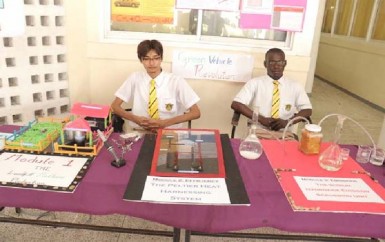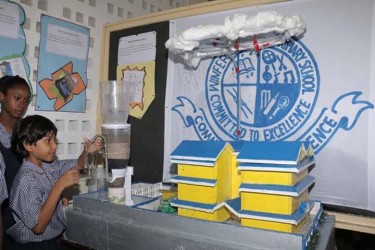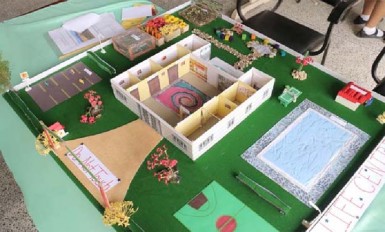Exhibits that focused on alternative energy, clean energy and energy efficiency stole the spotlight yesterday when the Science, Mathematics and Technology fair opened at the Queen’s College Auditorium.
The fair, themed ‘Solving 21st Century Problems in a Sustainable and Environmentally Friendly Manner’ is a collaborative effort by the Department of Education, the National Centre for Educational Resource Development (NCERD), the Burrowes School of Art and the Technical Vocational Educational Institute (TVET). The event, which concludes today, is aimed at drawing creative, scientific and practical solutions in dealing with community-based problems.
Tasked with designing miniature models of their ideas that can be replicated on a grand scale, students revelled in their accomplishments. Their dedication and commitment were evident as they were grilled by the judges and onlookers about the exact science behind their energy sector models.

They demonstrated with the ‘Green Vehicle project’, for example, that landfills can be used to derive fuel that can be used to run ordinary vehicles given a few alterations. Other alternative energy sources on display included bio fuel derived from used vegetable oil and ethanol from algae. Climate change received significant consideration by the students as they sought to demonstrate measures that can be undertaken to reduce emissions of greenhouse gases. Communities were modelled to accommodate solar panels, wind turbines, collecting rain water, car-pooling, reducing waste and overconsumption and recycling garbage among other methods. Some even turned to demonstrating how recycling garbage can beautify homes and classrooms through the creation of ornaments, flowers, bookshelves, cups and other household amenities, thus encapsulating the visual arts aspect of the fair.
The agricultural industry was not left out of the young scholars’ proposed initiatives as several sought to display the engineering of hydroponic farming systems, i.e. systems using only water to farm.
This system gives rise to advantages such as increased yields, no weeds and no soil-borne diseases. Students enlightened visitors of the versatile use of natural substances like turmeric to combat physical illnesses; wholesome manufactured items like mosquito repellent, candles, vinegar, tea, cloth and preservatives like honey. Some of the food items on display were papaw, lemon, sorrel, breadfruit and pomegranate.

On the electronic/technology side, they showed how by using electronic devices for teaching, administering and marking test scripts, schools could reduce the dependency on paper, save trees and improve efficiency.
The fair saw the participation of over 41 schools across the primary and secondary sectors. It is a competition, with judges’ assessments being made based on innovation, presentation and knowledge among other things. Today at 13:00 hrs, the winners will be announced according to six divisions: Lower Secondary (Grades 7-9), Upper Secondary (Grades 10-11), 6th Form, Tertiary (Out of school) and Observer. The ceremony will be attended by Education Minister Priya Manickchand.
The green vehicle revolution
This eco-friendly project by Nicholas Elliot and Lawrence Faria of Queen’s College (QC) demonstrates in a practical manner how Guyana can contribute towards a greener economy via its motor vehicle users, effectively supplementing the Low Carbon Development strategy. The well-constructed demonstration showed exactly how methane fuel would be collected from the Haags Bosch landfill via extraction pipelines which would lead into purifier machines then into gas compressors and into storage tanks like that of a gas station. Methane emits 1/16 of the carbon emissions of gasoline or diesel.
Combustion engine motor vehicles, with a few alterations can use this alternative form of fuel. A simple installation of a pressurized stainless steel tank and fuel lines combined with a pressure regulating valve and replacement of all the rubber parts in the engine block with ceramics would do the trick. To further reduce the carbon emissions by 60%, a sodium hydroxide emission scrubbing unit can be installed in the trunk. By collecting the exhaust fumes and infusing them with sodium hydroxide, sodium bicarbonate, a key ingredient of production of detergents can be formed and sold to chemical companies.

This extravagant display was further complemented with an oral presentation by the two very knowledgeable lower 6th form students. These young men impressed everyone who sought an understanding of the project. They said the process is currently being utilized in Malaysia and it is their hope that it will be implemented in Guyana.
Water filtration system
Plagued by constant flooding due to rain and poor irrigation, six Winfer Gardens Primary School students decided to build an elaborate replica of a practical initiative they hope would be implemented to resolve their plight. In a functioning structure which demonstrated actual rainfall over the school’s roof, water collected into the yard was diverted into a reservoir which then funneled it into a simple filtration device that employed a biological sand filter and activated carbon to purify the water for drinking purposes. This purification process, though slow, occurred before the eyes of the onlookers as the children demonstrated.
Safe life
QC students Akarshini Singh and Ashmita Tulsi were the only ones who focused on a social and behavioural problem plaguing Guyana today. Moved by the suicide rate and the domestic problems facing so many children including their friends, they opted to present a dynamic form of treating patients suffering from depression who are contemplating suicide. They incorporated physical activities such as song, dance, exercise and gardening, which they believe would aid in the depressed being more open and receptive to counselling. A healing sanctuary they called the potential institute to avoid the stigma of seeking counselling, these girls hope to someday open its doors when they’ve concluded studies in medicine and psychology.





